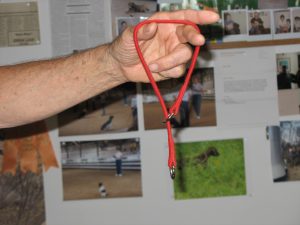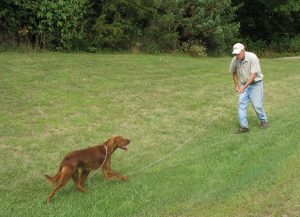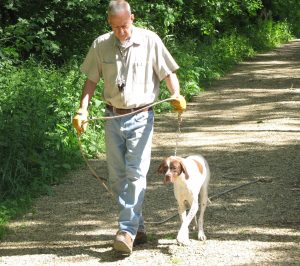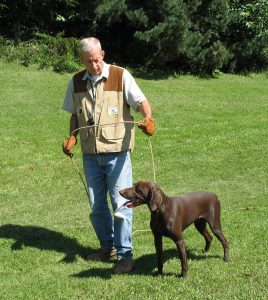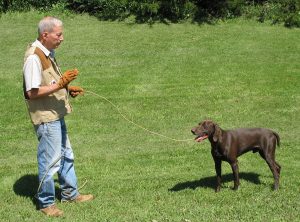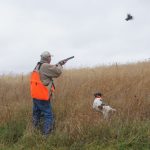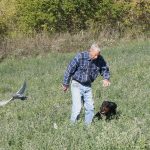POINTING DOG POINTERS: Starting the Pointing Dog Pup – Yard Work
By Bob and Jody Iler
Last but not least in our series on our started dog training program is yard work, or obedience. We’ve placed it at the end of for a reason! With a young dog, we want the emphasis on his initial development to be on birds and field work to build his enthusiasm and confidence. This will give our pup the hunt, drive, and focus he needs for subsequent gun development. We want to make sure our pup is at this point before we start a regular, steady program of control work.
We keep our yard work simple for the started pup, limited to three main commands: heel, whoa, and here. With these commands pup will learn to walk by your side (heel), to stay in place in a standing position (whoa), and to come when he is called (here).
Many pups come to our kennel with some of these basics (and more) already instilled. Some pups will happily retrieve dummies or balls on command as well. Their owners have spent time with them working on obedience and fetch training, and they’re understandably proud to show off what their pups can do. Yet, if these same owners had called us when they first got their pups, we would likely have told them to hold off on those things and just let their pups be pups until they bring them for training.
Why?
Pups with too much obedience training will sometimes be inhibited in the field or stay close to our side as we try to introduce them to birds. If they’ve been taught to sit or sit/stay, these pups will sometimes sit on point as they learn to scent and find birds. Some of the pups that have had retrieving “lessons” and been allowed to play tug of war with dummies may prove hard-mouthed later as we work on retrieving birds.
Which Approach for Your Pup?
In the March/April 2005 issue of the Pointing Dog Journal, we wrote an article called “Shuffle the Cards.” In it, yard work (A), bird and field work (B), and gun development (C) are depicted on three flash cards. The order in which the three cards are “shuffled” reflects the sequence of each pup’s training, and that order would be different for different pups.
First, though, you have to determine your pup’s temperament!
For example, a bold pup that is tough, aggressive, and independent would definitely need some control work. Because of his rambunctious and fearless nature, he’d need to have this control instilled in him initially, but this generally wouldn’t daunt his enthusiasm for bird and field work. The bold pup’s sequence of training would be A, B, C, with the yard work practice continuing throughout the started dog program.
On the flip side, a soft pup that is somewhat timid, shy, or reserved would best benefit from thoughtful, slow, and easy introduction to birds with careful attention to his responses as training progresses. With soft pups, the focus is on confidence building, with lots of praise and encouragement. Though often slower to come along, with patience and time the soft pup can become an outstanding bird dog. The soft pup’s sequence of training, then, would be B, C, A. We want our soft pup to be bird crazy, hunting with zest, and paying no attention to the gun – before we start working on control.
The average pup is the ideal: sound and interested in the world around him, willing to learn and be your partner. He adapts positively to new situations and experiences and is eager to please you. With this pup, we’ll introduce light-handed yard work right along with our bird and field work, continuing with it through gun development. Like the bold pup, the average pup’s sequence would be A, B, C.
Here
The here (come) command is the most important of all and can save your dog’s life. Ironically, your pup must be ranging out, paying no attention to you, in order to teach this command effectively, so we don’t want to hack pup in by teaching heel first. You’ll need a 15-foot checkcord and either a nylon or chain slip correction collar. Flat collars are not good for training, unless your pup is soft and very biddable.
Work in a long driveway, a big yard, or a field with short cover (and no birds). Start walking forward with your pup and let him range out far ahead of you, sniffing and exploring. When your checkcord is almost taut and pup has his mind on everything else but you, pop the checkcord smartly and call “Here” at the exact same time. As he looks up, surprised, pop the checkcord again and call “Here,” with firmness and authority, and guide him to you as you back up. Pat your leg, get excited, use lots of praise – but insist that he come directly to you right away. If necessary, pop the checkcord as you give the command again. When he reaches you, praise him and make a big deal! Using treats as a reward initially are okay, but eventually we want our pup to work for the praise and partnership that we develop over time.
Now, set out again in another direction. Once pup has forgotten the first lesson and is interested in the world around him, repeat the entire process. In his first session on here, you’ll probably do this exercise about four or five times, and already you may notice that pup will start to anticipate your here command and begin to stay closer to you. After a week of training sessions on this command, your pup should be spinning around and running back to you without a correction when you call “Here.” As time progresses, you can practice this command in other scenarios. When you do, make sure that you have the checkcord and training collar on – if you can’t enforce the here command, you’ll be undoing your training.
Heel
Once our pup has learned to come reliably when called, we’ll start out again in our training area, walking forward as usual. As we’ve said, you’ll notice pup will hang close to you, anticipating that you’ll be calling him to you. But now, as you walk forward, gather your checkcord up to about six feet, letting the rest trail behind you. Walk forward briskly and then do a quick about face to your right and continue walking in a straight line. Since pup is hanging close by, he’ll likely turn too. Guide him to your left side as you make your about face and keep walking.
After a bit, make another about face to your right and continue walking, patting your left side and encouraging pup to stay next to you. Every time he forges ahead of you, do another about face and go in the opposite direction with pup at your side. As you do the about face, you may need to pop the dog with the checkcord to get his attention to turn and stay with you. Soon he should be heeling along nicely.
Now, instead of doing a complete about face to the right, just make a righthand turn, encouraging pup to keep next to your left side, and start adding the command “Heel” with a correction pop as you turn. Work in a large rectangle pattern, making right turns only, until he is heeling along reliably. Left turns will be trickier, as you are turning in toward your pup and will need to draw up your checkcord as you turn and lightly bump him with your left leg.
As these lessons progress, you can switch to using a six-foot leather or cotton web lead with his training collar. In time, you can practice heeling in other venues and around other distractions, but remember, we still have a young pup here, so we’re not demanding college level training at this stage.
Whoa
Once our pup is heeling along at our left side fairly well, it’s time to add the whoa command. You can use either the 15-foot checkcord (with most of it trailing behind you) or the six-foot training lead, along with the training collar. Heel along with your pup and get the edge off him first, and then, slow your pace and come to a stop. As you do so, transfer the checkcord to your right hand, holding it about a foot above the pup’s neck. At the same time, reach back and put your left hand below pup’s right flank, keeping him in a standing position. Wait a few seconds and resume heeling. Again, slow to a stop and repeat the sequence; as he gets the idea, gently and quietly command pup to “Whoa.”
Don’t make pup whoa for long initially. If he wriggles around and won’t be still, continue heeling and keep working at it until he gets the idea. And once he does, you can begin to increase the time he is on the whoa. Eventually, you will step around directly in front of him, keeping him in the whoa position, and then return back to your original place on his right. With time and practice, you can move completely around pup while he’s on the whoa and also begin to increase your distance away from him in front. Don’t be in a hurry; this takes time and you’re laying the groundwork for future whoa training down the road.
Pointing Dog Pointers features monthly training tips by Bob and Jody Iler, who own Green Valley Kennels in Dubuque, Iowa. Bob and Jody have trained pointing dogs for over 35 years and have written many articles for Pointing Dog Journal.



